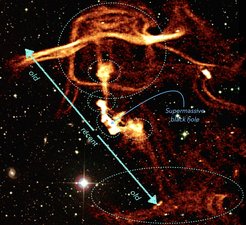Radio and X-ray observations reveal spectacular fossils in nearby group of galaxies
Combining radio and X-ray images by LOFAR and SRG/eROSITA, respectively, astrophysicists have studied a group of galaxies where an incredibly rich system of radio-bright filaments are embedded in an atmosphere of hot X-ray emitting gas. These filaments were initially produced by outflows from a supermassive black hole a few hundred million years ago – roughly, when dinosaurs appeared on Earth. Despite their impressive age, the filaments still survive and form an intricate maze of threads and geometrical patterns that are reminiscent of structures formed when buoyant plumes rise in the atmosphere. The lack of full mixing between the X-ray and radio-emitting plasma is particularly interesting for physical models of the so-called mechanical AGN feedback.

Massive halos in our Universe, such as giant elliptical galaxies, groups and clusters of galaxies largely consist of Dark Matter, which is responsible for their deep gravitational wells. Part of their mass, though, is normal matter, i.e. baryons, which form a hot gaseous atmosphere filling the halo potential well. At temperatures of 10 or 100 million degrees, this gas can be readily studied in X-rays with modern space observatories, such as Chandra, XMM-Newton, and SRG.
In the central region of each halo, the gas density is high and the gas could cool and condense, providing fuel for the formation of new stars. However, somehow this does not happen – a puzzle that gave rise to the “mechanical AGN feedback” paradigm more than 20 years ago. Here AGN stands for the Active Galactic Nuclei – a supermassive black hole at the center of a halo. The paradigm, also known as “radio-mode AGN feedback”, is based on three main conjectures, namely (i) the AGN can supply a sufficient amount of mechanical energy in the form of jets and/or outflows to prevent cooling of the gas; (ii) this energy can be efficiently converted into gas heating; and (iii) the system self-regulates so that approximately the right amount of energy is released by the AGN.
These assumptions can be corroborated by a combination of simple energetic estimates, energy conservation law arguments, and various analytic and numerical models of the feedback loop. However, it is difficult to understand from first principles what physical processes are responsible for dissipating the energy released by the supermassive black hole and eventual gas heating. There are simply too many possibilities, including waves, turbulence, mixing, cosmic rays... One has to resort to observations to find clues to this question.

Here comes NEST200047: a nearby group of galaxies, some 75 Mpc (about 250 million light-years) away from us, observed by LOFAR and SRG/eROSITA in their respective radio and X-ray surveys (Fig.1). The characteristic wavelengths of the surveys differ by a factor of about 5 billion, providing a highly complementary view on the galaxy group. These data confirm that a hot X-ray emitting gaseous atmosphere is centered on a giant elliptical galaxy and that its core is bright in the radio band – typical ingredients of a group of galaxies where the role of AGN feedback is important.
But NEST200047 turned out to be a very special object. The radio emission comes from a rich and intricate system of filaments covering a region of over 200 kpc. Its structures resemble vortex rings, somewhat similar to those found in the famous nearby galaxy M87, but on much larger spatial scales. The combined radio and X-ray views suggest that the radio-emitting plasma was stretched and deformed by complicated motions over the course of more than hundred million years. At the same time, it does not mix with the thermal plasma on small scales, emphasizing the role of magnetic fields. This also implies that mixing is not required for heating of the X-ray-emitting gas as, in fact, foreseen by the original flavor of radio-mode AGN feedback models.
All in all, NEST200047 represents a unique example of an object, where fossils of AGN activity can be traced over hundreds of millions of years (Fig.2).
More information
Please note that the images were modified for this web article. See the Nature publication (left column) for original images.
The SRG spacecraft was designed by the Lavochkin Association, Roskosmos corporation and launched on July 13, 2019 with a Proton launcher from the Baikonur cosmodrome. The SRG observatory was built with participation of DLR, Germany in the framework of the Russian Federal Space Program by the initiative of the Russian Academy of Sciences represented by its Space Research Institute (IKI). The observatory carries two unique X-ray grazing incidence telescopes: ART-XC (IKI, Russia) and eROSITA (MPE, Germany). The eROSITA telescope was built under the leadership of the Max-Planck-Institute for Extraterrestrial Physics (MPE) and DLR. The SRG spacecraft is operated by Lavochkin Association and Deep Space Network Antennae in Bear Lakes, Ussurijsk, and Baikonur, funded by Roskosmos.
LOFAR is the Low Frequency Array designed and constructed by ASTRON. It has observing, data processing, and data storage facilities in several countries, which are owned by various parties (each with their own funding sources), and that are collectively operated by the ILT foundation under a joint scientific policy.
This study is a result of the combined efforts of experts in radio, optical and X-ray astronomy from the Universita di Bologna, INAF, ASTRON, Leiden Observatory, Sternwarte Hamburg, Kazan University, Space Research Institute (IKI), Max Planck Institute for Astrophysics, University of Hertfordshire, IASF, DIAS, SRON, WPI, Observatoire de Paris, Rhodes University.













